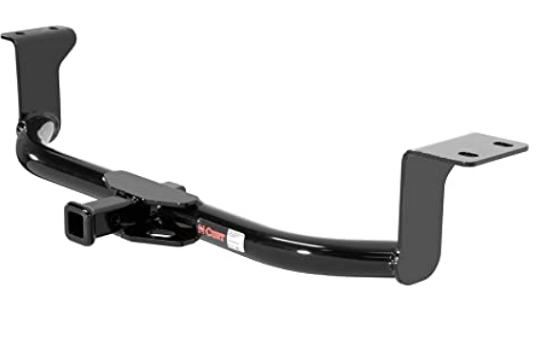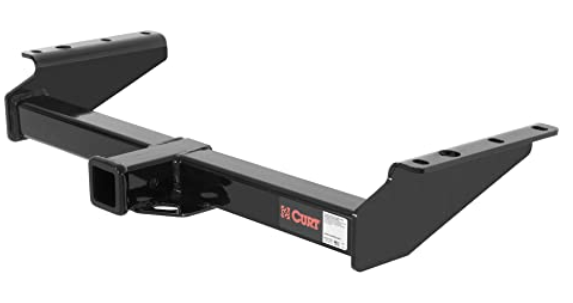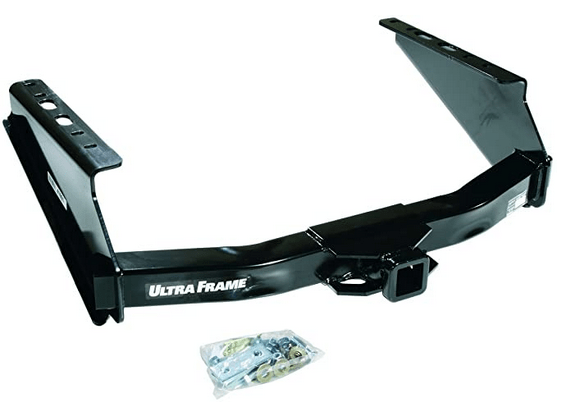Hitch receivers (or trailer hitches) are devices that are attached to a vehicle for providing a hitch for a trailer, a boat lift, a cargo carrier or a bicycle rack so they are quite universal in this sense. Hitches are mounted to the frame of the vehicle, near to its rear axle. Once a trailer hitch is installed, it can not be removed (technically it can be but it won’t be easy).
Let’s take a look at how they look like.


Hitch receivers are divided into 5 classes. There are 3 main parameters that determine to which class a particular hitch receiver belongs:
- Receiver tube size (the inside dimensions of a hitch receiver). There are four sizes: 1-1/4-inch, 2-inch, 2-1/2-inch and 3-inch. Class 1 and 2 hitches have 1-1/4-inch tubes, Class 3 and 4 have 2-inch tubes.
- GTW (Gross trailer weight) capacity. This parameter is pretty much straightforward and tells how much weight a trailer hitch can tow. Class 1 hitches can tow up to 2,000 lbs (907 kgs) whereas Class 5 hitches are capable of towing up to 20,000 lbs (9071 kgs).
- TW (Tongue weight) capacity. This parameter tells how much weight you can put on a trailer hitch vertically. It is important to consider TW capacity if you are planning to attach a bike rack or a cargo carrier to your trailer hitch. Class 1 hitches have 200 lbs (90 kgs) TW capacity and Class 5 Hitches can carry up to 2,700 lbs (1,224 kgs).
Class 1 trailer hitches (receivers)

The class 1 hitch receiver can tow up to 2,000 pounds. The tongue weight capacity is 200 pounds.
A class 1 hitch receiver is a type of trailer hitch that is designed for hauling a light-duty trailer. For example, you may use this hitch if you have a camper or boat on a trailer that you want to tow from your vehicle from time to time.
A class 1 hitch receiver can fit on any standard vehicle and it’s the most common size on the market today. This receiver tube has a 1-1/4-inch diameter and can fit any standard size ball mount as well as most other types of trailers as long as they are within the 2,000lb maximum weight limit.
Class 2 trailer hitches (receivers)

The Class 2 Hitch Receiver is a standard-size receiver tube that can tow up to 3,500 pounds of weight. This receiver tube is built to withstand heavy-duty use and has a tongue weight capacity of 350 pounds.
The Class 2 Hitch Receiver is perfect for those who need a sturdy hitch to tow their trailer or boat around. It has the ability to take on rough terrain and keep its shape, so you don’t have to worry about it getting damaged easily.
Class 3 trailer hitches (receivers)

The class 3 hitch receiver is a special type of trailer hitch that can tow up to 8,000 lbs. It has a 2-inch receiver tube size and has tongue weight capacity of 800 lbs.
This type of hitch receiver is often called a “tow hitch” or “tow bar.” They are popular with RV owners who want to use their vehicle to tow trailers or other large objects. Some people also use them on their SUVs to pull boats or other cargo.
Class 4 trailer hitches (receivers)

The class 4 hitch receiver is the most powerful of the hitch receivers on larger trucks. It has an opening that is 2″ in diameter and can tow up to 10,000 pounds. The tongue weight capacity of a class 4 hitch receiver is 1,000 pounds.
It can handle anything you can throw at it as long as it has a 2-inch receiver tube size. A class 4 hitch receiver should be your go-to for larger trucks and commercial vehicles.
Class 5 trailer hitches (receivers)

The Class 5 Hitch receiver is the largest receiver tube size in the United States. It is rated to tow up to 20,000 lbs, which is much more than you’ll need for personal use. It has a tongue weight capacity of 2,700 lbs.
The receiver tube size of this hitch receiver is 2 inches in diameter and it has a tongue weight capacity of 2,700 lbs. The Class 5 Hitch receiver can tow up to 20,000 lbs which is significantly more than what you would need for personal use. That’s why it is deemed more like a commercial class.
Which trailer hitch class do you need for hitch bike racks?
I would recommend class 2 trailer hitches for hitch bike racks because of their increased TW (tongue weight) capacity. Class 2 has 350 lbs TW capacity whereas class 1 has 200 lbs.
A typical hitch bike rack weighs around 60 lbs so you will have 140 lbs left to carry your bikes. It is true that class 1 will be more than enough in most cases, but the difference in price between class 1 and class 2 hitch receivers is rather insignificant so why not buy a higher load capacity hitch from the very beginning. You might need it in the future for carrying a cargo carrier or towing a heavier trailer.
Which trailer hitch class do you need for hitch cargo carriers?
I would recommend class 2 or class 3 trailer hitches if you would like to attach a cargo carrier to it.
Class 2 will be more than enough for most people (up to 350 lbs TW capacity). However, some cargo carriers are quite heavy-duty (can carry 500-600 lbs) and you are planning to use them to the full extent, then it will require a class 3 trailer hitch (up to 800 lbs TW).
FAQ
Can you put a trailer hitch on any car? No, trailer hitches are not universal so you need to make sure that it fits your car’s model.
How high should a trailer hitch be off the ground? A good rule of thumb would be at least 11 inches high from the ground.
How much do trailer hitches cost? A trailer hitch normally costs around $300-$500 depending on its class and manufacturer.
How much does it cost to get a trailer hitch installed? To get a trailer hitch installed you will have to pay around $100-$400 for the installation.
Can you install a trailer hitch yourself? It is possible to do it yourself. However, it will probably take two hours plus and the right tools.
